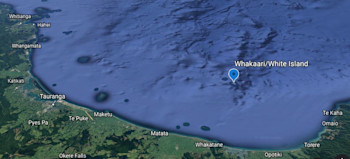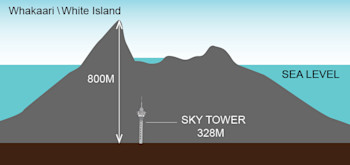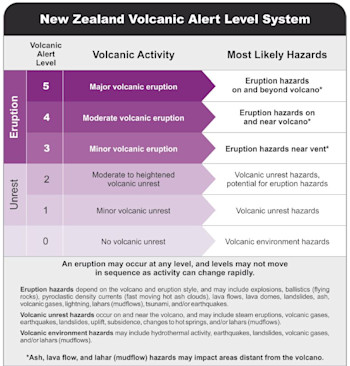
Whakaari/White Island Frequently Asked Questions
Whakaari/White Island is New Zealand’s most active cone volcano which has been built up by continuous volcanic activity over at least 150,000 years.
How far from the mainland is Whakaari/White Island?
Whakaari/White Island sits 48km offshore from Whakatane, on the North Island of New Zealand.
About 70 percent of the volcano is under the sea, making this a very large volcanic structure.
Can the Whakaari/White Island eruption impact the other volcanoes in New Zealand?
Although all the active volcanoes in New Zealand are linked broadly via the plate boundary, they do however stand alone. Activity or volcanic unrest at one does not have an influence or impact on any of the others. The eruption at Whakaari/White Island is not going to cause other volcanoes or geothermal systems in New Zealand to change.
Can an eruption cause a tsunami?
Tsunami have been observed or recorded during or as a consequence of volcanic eruptions. The primary causes are large volumes of debris flowing into the sea or the submarine portion of the volcano failing.
Would an eruption impact mainland New Zealand?
Due to Whakaari/White Island’s distance from the North Island coast there is an extremely low likelihood of any effects from an eruption on the mainland. If there were any effects, the most likely are fine ash falls (like pollen or talcum powder) and the smell of volcanic gas, which are more likely to just be a nuisance.
On the scale of past eruptions - where does this sit?
Whakaari/White Island is a very active volcano. In New Zealand’s recorded history there have been many small and short-lived eruptions documented before 1976.
In 1976, a significant eruptive episode began at Whakaari/White Island and it lasted through to 2000. During this eruptive episode many significant eruptions occurred impacting the island. Several of the events were slightly larger than Monday’s (9 December) fatal eruption.
In a global perspective these are small eruptions, but the impacts are large as the island is small and everywhere on the island is close to the active vents.
What do New Zealand’s Volcanic Alert Levels mean?
To help us communicate the current status of the active volcanoes in New Zealand we have the New Zealand Volcanic Alert Level System. This system defines the current level of activity at each active volcano. The alert levels range from 0 to 5, where level 0 is no volcanic unrest and Level 5 is a Major Volcanic Eruption in progress, that produces hazards well beyond the volcano.
We use Volcano Alert Bulletins to communicate the New Zealand Volcanic Alert Level and any other important information about the status of a volcano. These are shared with responding agencies, industries, media and the public about the status of the volcanoes.
The Alert Level number itself is a really coarse mechanism to give a heads-up for a status change in the volcano. The bulk of the information about what's happening and what might happen from a scientific point of view are published by way of Volcanic Alert Bulletins.
Here is a short video showing examples of our volcanoes over the years, at the each of the various levels:
Does Volcanic Alert Level 2 mean the volcano will erupt?
Our Volcanic Alert Level system was revised in 2014. Levels 1 and Level 2 communicate periods of volcanic unrest or pre-eruptive activity. Levels 3, 4 and 5 correspond to small, medium/moderate and large eruptions. There have been times in the last five years, where Whakaari/White Island has gone to Level 2 with no subsequent eruption. However, it is also possible to have eruptions occur from Level 1. In both cases, Level 1 or 2, it's possible to go to an eruption with no useful short-term warning.
In recent weeks we moved Whakaari/White Island to Volcanic Alert Level 2 which is moderate to heightened unrest, indicating monitoring parameters had increased. We published frequent Volcanic Alert Bulletins, indicating the volcano appeared to be more active and there is perhaps an increased likelihood of eruption.
Need to Talk? If you would like support or advice, have feelings of anxiety, stress, prolonged fear, hopelessness or anger, or if you just need to talk with someone. Please text or phone 1737 to speak to a trained councillor in the National Telehealth Service. Its free to call or text.





